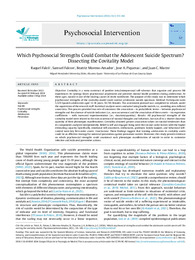Por favor, use este identificador para citar o enlazar este ítem:
https://hdl.handle.net/11000/36194Registro completo de metadatos
| Campo DC | Valor | Lengua/Idioma |
|---|---|---|
| dc.contributor.author | Falcó García, Raquel | - |
| dc.contributor.author | Samuel Falcon, Samuel | - |
| dc.contributor.author | Moreno-Amador, Beatriz | - |
| dc.contributor.author | Piqueras, Jose A. | - |
| dc.contributor.author | Marzo Campos, Juan Carlos | - |
| dc.contributor.other | Departamentos de la UMH::Psicología de la Salud | es_ES |
| dc.date.accessioned | 2025-03-27T13:15:54Z | - |
| dc.date.available | 2025-03-27T13:15:54Z | - |
| dc.date.created | 2024 | - |
| dc.identifier.citation | Psychosocial Intervention, Vol. 33, Nº. 3, 2024 | es_ES |
| dc.identifier.issn | 1132-0559 | - |
| dc.identifier.uri | https://hdl.handle.net/11000/36194 | - |
| dc.description.abstract | Objective: Covitality is a meta-construct of positive intra/interpersonal self-schemas that organize and process life experiences. Its synergy favors psychosocial adjustment and prevents mental health problems during adolescence. At these ages, suicide is one of the leading causes of death worldwide. The purpose of this study was to determine which psychosocial strengths of the covitality model could combat adolescent suicide spectrum. Method: Participants were 5,528 Spanish adolescents aged 12-18 years, 50.74% females. The assessment protocol was completed in schools, under the supervision of the research staff. Statistical analyses were conducted using hurdle models, i.e., modeling zero-inflated count data. This process provided two sets of outcomes: the association – in probabilistic terms – between psychosocial strengths and the absence of suicide indicators (i.e., non-occurrence) and the association of these assets – via regression coefficients – with increased experimentation (i.e., duration/quantity). Results: All psychosocial strengths of the covitality model were related to the non-ocurrence of suicidal thoughts and behaviors, but not all to a shorter duration/ quantity of their phenotypic manifestations. Covitality obtained greater association values on suicidal tendencies than its components analyzed independently. Belief in self and engaged living were the second-order factors with the higher estimating capacity. Specifically, emotional self-awareness, enthusiasm, gratitude, family support, and behavioral self- control were key first-order assets. Conclusions: These findings suggest that training adolescents in covitality assets could be an effective strategy for universal prevention against premature suicide. Moreover, this study provide evidence on which psychosocial strengths could counteract each phenotypic manifestation of suicide in order to customize selective and indicated preventive actions. | es_ES |
| dc.format | application/pdf | es_ES |
| dc.format.extent | 14 | es_ES |
| dc.language.iso | eng | es_ES |
| dc.publisher | Colegio Oficial de la Psicología de Madrid | es_ES |
| dc.rights | info:eu-repo/semantics/openAccess | es_ES |
| dc.rights | Attribution-NonCommercial-NoDerivatives 4.0 Internacional | * |
| dc.rights.uri | http://creativecommons.org/licenses/by-nc-nd/4.0/ | * |
| dc.subject | Suicide | es_ES |
| dc.subject | Psychosocial strengths | es_ES |
| dc.subject | Covitality | es_ES |
| dc.subject | Adolescents | es_ES |
| dc.subject | Prevention | es_ES |
| dc.subject.other | CDU::1 - Filosofía y psicología::159.9 - Psicología | es_ES |
| dc.title | Which Psychosocial Strengths Could Combat the Adolescent Suicide Spectrum? Dissecting the Covitality Model | es_ES |
| dc.type | info:eu-repo/semantics/article | es_ES |
| dc.relation.publisherversion | 10.5093/pi2024a9 | es_ES |

Ver/Abrir:
2024_12024_132-0559-pi-33-3-02024_133 (2024_1).pdf
408,11 kB
Adobe PDF
Compartir:
 La licencia se describe como: Atribución-NonComercial-NoDerivada 4.0 Internacional.
La licencia se describe como: Atribución-NonComercial-NoDerivada 4.0 Internacional.
.png)